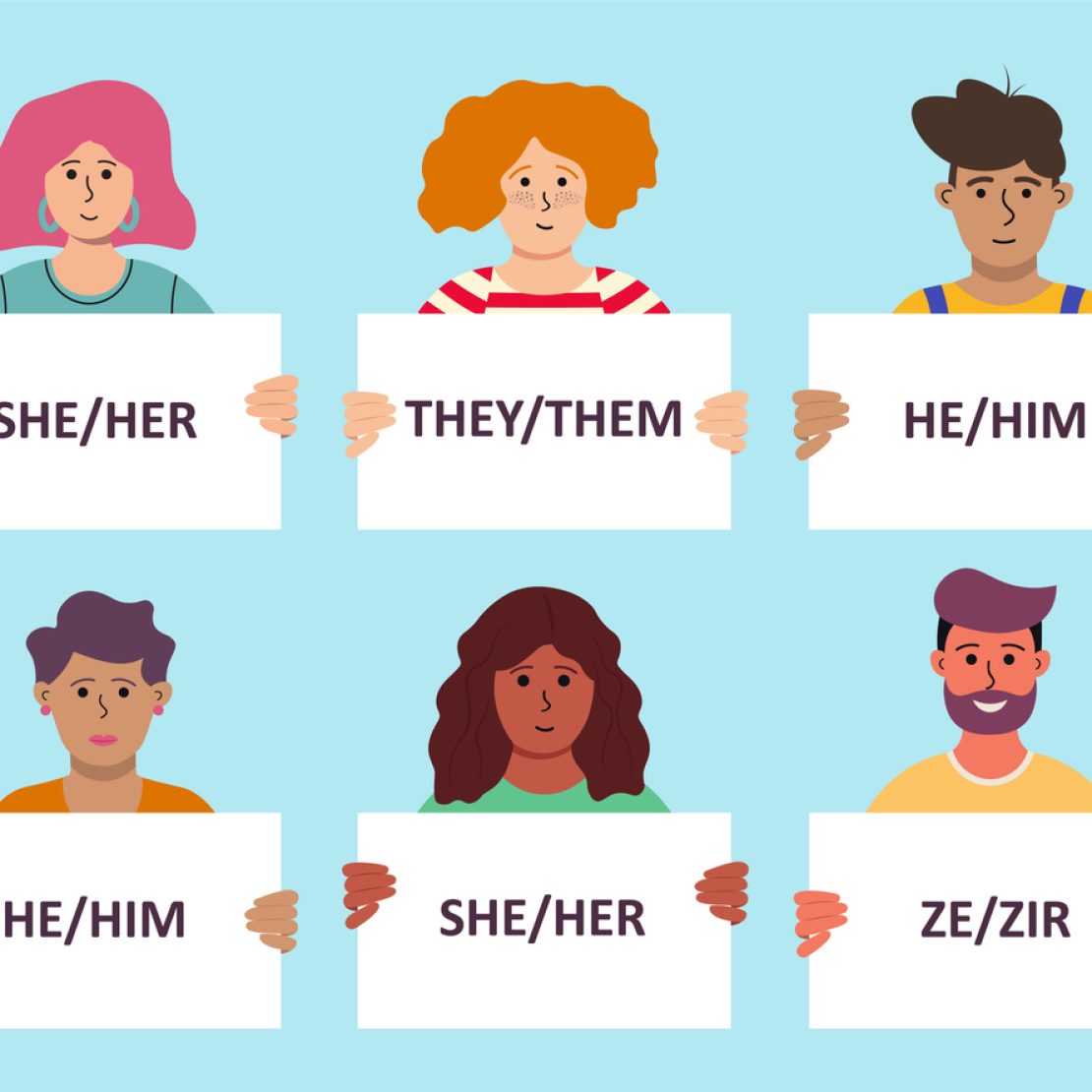
A Guide to Understanding & Using Affirming Pronouns
Having a hard time remembering your lesson in second grade about what pronouns are? We’ve got you! If you are unsure of what a pronoun is, how to use pronoun stickers, or want to learn more about using gender neutral pronouns, our awesome team member Maybe Burke, has written a blog post to get you started!
Before we begin, this post will specifically be talking about pronouns in the English language. The same rules and words don’t apply for all languages, this information is tailored specifically for English speakers. If you would like to learn this information with us live, check out our Pay What You Can miniwebinar – Getting Comfortable with Pronouns!
What Are Pronouns?
For the most part, pronouns are words that we use to replace nouns in a sentence. There are many different kinds of pronouns in the English language, but when we’re talking about inclusive and affirming pronouns for trans and non-binary people, we are specifically talking about personal third-person pronouns.
Third-person pronouns are the words that we use instead of someone’s name. For example, if we are talking about Stephen being on the way to facilitate a meeting, we would say “Stephen is on the way to his meeting” or “He is on his way to his meeting.” In this example, we are using the third-person pronouns “he” and “him” instead of using Stephen’s name.
Why Are Pronouns Important?
Words and language are fundamental to the ways most people understand and navigate the world. The words we use to talk about people, specifically trans and non-binary people, can be very important. Not only is it respectful and affirming to use the right pronouns for someone, but it also helps to shape the way you think about that person. If you are using she/her/hers pronouns for a person, you are more likely to subconsciously think of that person in line with other things associated with women and femininity. This is because most women in our language are using she/her/hers pronouns and it’s easy for your brain to follow that pattern. By this same token, if you are to use gender neutral language and pronouns for a person, you are less likely to associate them with gendered expectations, and more likely to think of that person in line with non-binary people.
Examples of Pronouns
She/her/her/hers/herself
 Most women go by she/her pronouns. She/her is also the pronoun most people use when they assume someone to be a woman.
Most women go by she/her pronouns. She/her is also the pronoun most people use when they assume someone to be a woman.
She went to her local grocery store to get food for herself.
Though she/her is used by most women, there are women who might use other pronouns. There are also people of other genders who might use she/her pronouns, and that’s completely valid!
He/him/his/his/himself
 Most men go by he/him pronouns. He/him is also the pronoun most people use when they assume someone to be a man.
Most men go by he/him pronouns. He/him is also the pronoun most people use when they assume someone to be a man.
He went to his local grocery store to get food for himself.
Though he/him is used by most men, there are men who might use other pronouns. There are also people of other genders who might use he/him pronouns, and that’s completely valid!
They/them/their/theirs/themself
 They/them pronouns, or singular they pronouns, are most commonly used by non-binary people who don’t identify exclusively as men or women.
They/them pronouns, or singular they pronouns, are most commonly used by non-binary people who don’t identify exclusively as men or women.
They went to their local grocery store to get food for themself.
People will also commonly use they/them pronouns when referencing a person whose gender is unknown.
They’re not wearing their seatbelt!
Singular they can also be a helpful replacement for “he or she,” or the misogynist use of “he” to generalize about all people.
*Some people might get confused with the use of singular they, as many folks were raised being taught that “they” needs to be plural. It’s important to note that language does shift and change over time, and that singular they has been in use since at least the 14th century.
**If you’re worried about people confusing the subject you’re talking about for a group of people, you can always clarify or restructure your sentences.
Jaime went to the grocery store to buy food.
There! We have the same example we’ve been using without needing to use a single pronoun at all.
Neopronouns
Neopronouns are any third-person pronouns that are not officially recognized in their language. There have historically been quite a few neopronouns in the English language, with origins in trans and non-binary communities, but also science fiction and other literature. Below are some of the most common examples of neopronouns. Please note that this is not an exhaustive list. It would be hard to make a list of every neopronoun without leaving someone out. These are just some of the more common examples.*
Ze/hir/hir/hirs/hirself or zie/hir/hir/hirs/hirself
 Ze/hir (pronounced like “here”) pronouns have historically been some of the most common neopronouns among trans and non-binary communities.
Ze/hir (pronounced like “here”) pronouns have historically been some of the most common neopronouns among trans and non-binary communities.
Ze went to hir local grocery store to get food for hirself. Zie went to hir local grocery store to get food for hirself.
These pronouns generally follow the grammatical patterns of she/her/hers.
Zie/zir/zir/zirs/zirself or Ze/zir/zir/zirs/zirself
 Ze/zir (rhymes with “here”) pronouns are derived from the above ze/hir, largely due to confusion of how to pronounce “hir.”
Ze/zir (rhymes with “here”) pronouns are derived from the above ze/hir, largely due to confusion of how to pronounce “hir.”
Ze went to zir local grocery store to get food for zirself.
These pronouns generally follow the grammatical patterns of she/her/hers.
Xe/xem/xyr/xyrs/xemself
 Another derivative, and pronounced the same as “ze,” Xe/xem pronouns use an X instead of Z. Xs are commonly seen as gender-neutral alternatives in terms like Mx. and Latinx.
Another derivative, and pronounced the same as “ze,” Xe/xem pronouns use an X instead of Z. Xs are commonly seen as gender-neutral alternatives in terms like Mx. and Latinx.
Xe went to xyr local grocery store to get food for xemself.
These pronouns generally follow the grammatical patterns of they/them/theirs.
Fae/fem/faers/faerself
 Another set of pronouns that generally follows the grammatical patterns of they/them/theirs is fae/fem. These pronouns swap out the “th” sound with a “f” sound.
Another set of pronouns that generally follows the grammatical patterns of they/them/theirs is fae/fem. These pronouns swap out the “th” sound with a “f” sound.
Fae went to faers local grocery store to get food for faerself.
Ey/em/eir/eirs/eirself
Ey went to eir local grocery store to get food for eirself.
These pronouns generally follow the grammatical patterns of they/them/theirs. (And for the most part are identical, just missing the “th.”)
Ne/nem/nir/nirs/nemself
Ne went to nir local grocery store to get food for nemself.
These pronouns don’t follow the grammatical forms of other pronouns.
Ve/ver/vis/vis/verself
Ve went to vis local grocery store to get food for verself.
These pronouns don’t follow the grammatical forms of other pronouns.
Multipronouns and No Pronouns
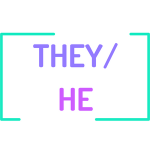
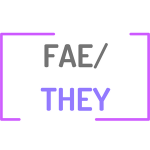
There are certain people who will want to go by some combination of pronouns. This can look a lot of different ways. There are people who might want to go by they/them in certain contexts and she/her in others. There might be people who will use he/him and ze/zir interchangeably and alternating. There might be people who give 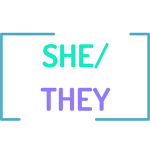 you an option of they/them or xe/xem, and you can use either of those.
you an option of they/them or xe/xem, and you can use either of those.
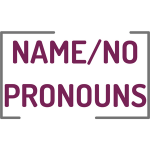
There are also plenty of people who might be fine with any pronoun being used for them, and some people who want to go by all pronouns.
By this same token, there are people who don’t use pronouns. It’s best to always refer to these people by name, and restructure sentences to avoid the need for pronouns.
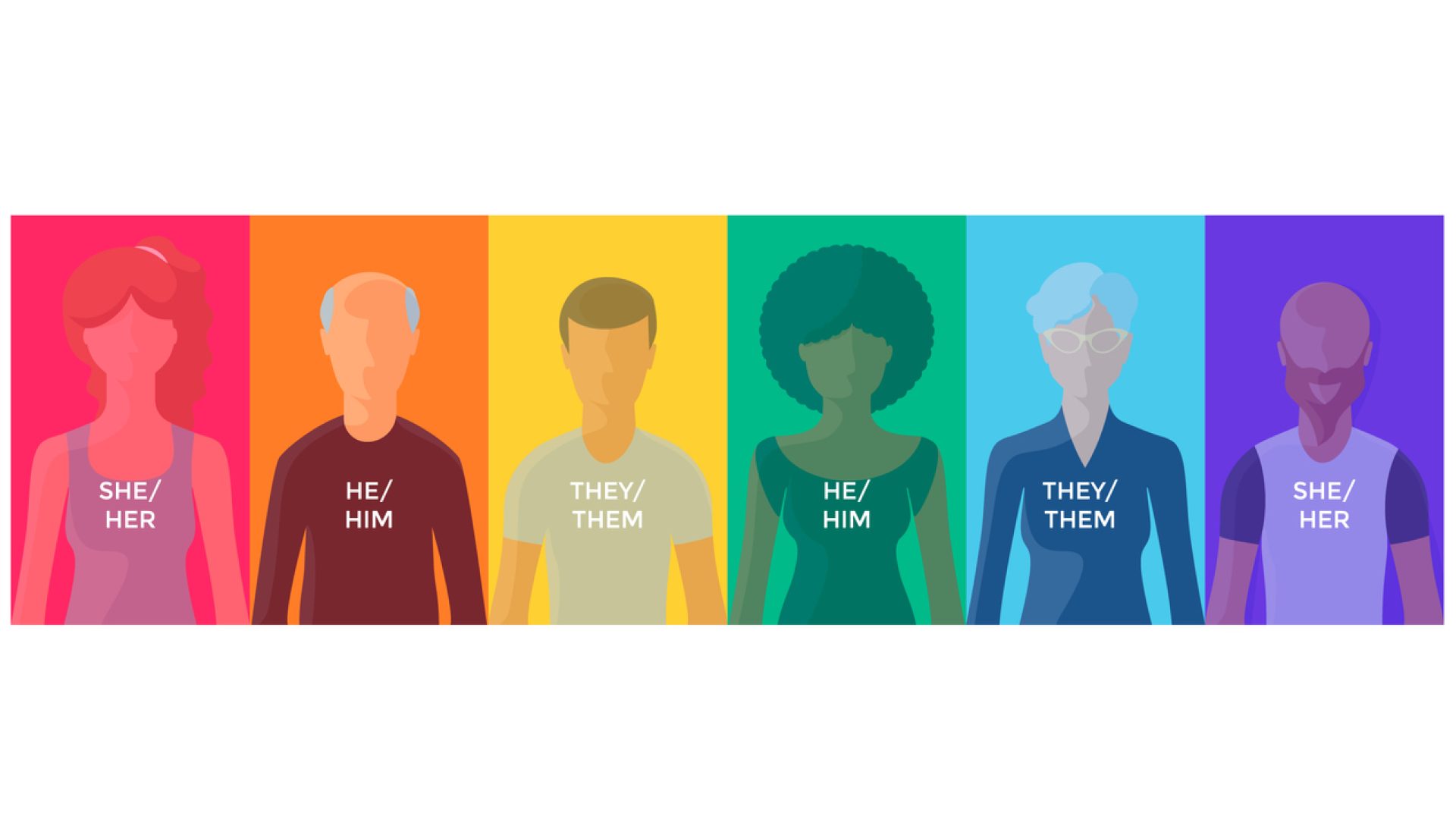
Asking for Pronouns
It’s important to note that pronouns are not always indicative of gender identity. Using he/him pronouns does not necessarily mean a person is a man. There are many non-binary folks who will use she/her or he/him pronouns, if that’s what’s right for them.
Sometimes you might hear a person say something like “all pronouns are good,” or “I don’t really care about pronouns.” And that’s true for some people! If you’re a cisgender person saying something like this, be careful. While one truly might not care what pronouns are used, one most likely has a pronoun that is used almost exclusively. If that pronoun being used is comfortable, then that’s enough. To say you don’t care about pronouns might feel like you’re being supportive, but can actually come off as dismissing the importance of pronouns for those who still have to fight for theirs. Your lack of care is a result of your cisgender privilege.
Why a person chooses to use a certain set of pronouns is up to that person. If there’s a non-binary person using she/her pronouns, then that’s probably a decision they’ve sat with for a long time. She shouldn’t need to explain her choice or her identity to other people.
If you’re not sure what pronouns to use for someone – it’s okay to ask! You can introduce your pronouns every time you give your name. “Hi, I’m Shelly, I go by she/her pronouns.” This opens the invitation for another person to name their pronouns. It’s best to keep asking everyone their pronouns, and not just the people you think might be trans and/or non-binary.
If you make a mistake: apologize, correct yourself, and move on. It’s always best to catch yourself before someone else has to point out that you misgendered them. If you don’t notice, and someone does call you out, it can be helpful to thank them for taking the time to remind you. Reframing corrections like these as gifts can be incredibly useful. That person is working with you to make sure your relationship improves!
https://www.mypronouns.org/mistakes
PRACTICE!
https://www.practicewithpronouns.com
There are several word games you can play to practice the use of pronouns you’re not used to. You can also tell an old fairytale, but use they/them or xe/xem for the protagonist. Go They For A Day and use they/them to refer to everyone you’re not certain goes by a different pronoun. There are plenty of ways to practice and grow on your own so you don’t put the burden of education on the trans and non-binary people in your life.
Allyship: Sharing Your Pronouns
If you are cisgender, you may not be fully aware of how many opportunities you have to help make the world easier for transgender and non-binary people. Everytime you send an email with your pronouns in your signature, or include your pronouns after your name in a Zoom call, you make it easier for a transgender or non-binary person to do so too. For in-person interactions, using pronoun stickers and buttons on nametags, lanyards, or backpacks are a great way to signal your desire to know someone else’s pronouns.